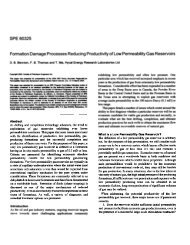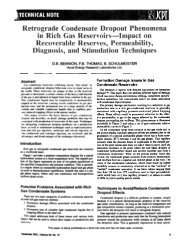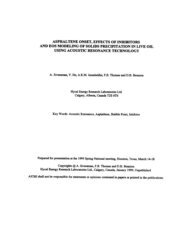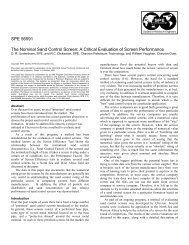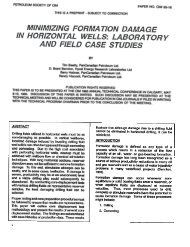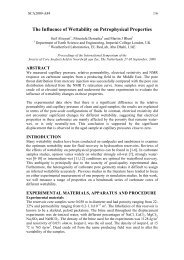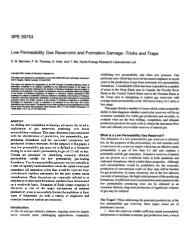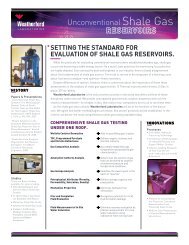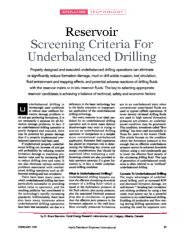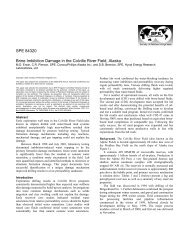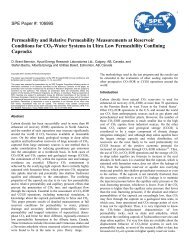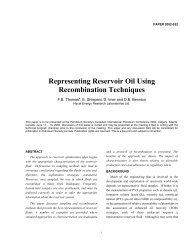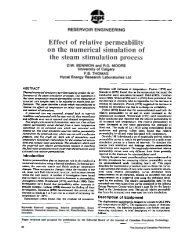the design & use of laboratory tests to reduce formation damage in ...
the design & use of laboratory tests to reduce formation damage in ...
the design & use of laboratory tests to reduce formation damage in ...
Create successful ePaper yourself
Turn your PDF publications into a flip-book with our unique Google optimized e-Paper software.
THE DESIGN & USE OF LABORATORY<br />
TESTS TO REDUCE FORMATION DAMAGE<br />
IN OIL & GAS RESERVOIRS<br />
By<br />
Eric C. Crowell, Hycal Energy Research labora<strong>to</strong>ries Ltd.<br />
D. Brant Bennion, Hycal Energy Research Labora<strong>to</strong>ries Ltd.<br />
F. Brent Thomas, Hycal Energy Research labora<strong>to</strong>ries Ltd.<br />
Douglas W. Bennion, Hycal Energy Research Labora<strong>to</strong>ries Ltd<br />
Prepared for presentation 0 <strong>the</strong> 13th Annual Conference <strong>of</strong> <strong>the</strong> Ontario Petroleum Institute,<br />
1991, Toron<strong>to</strong>, Ontario.<br />
Abstract<br />
Fonnation <strong>damage</strong> ca<strong>use</strong>s substantial reductions <strong>in</strong> 011<br />
and gas productivity In many reservoirs. Due <strong>to</strong> <strong>the</strong><br />
mechanics <strong>of</strong> flow In<strong>to</strong> horizontal wells and <strong>the</strong> fact that<br />
most horizontal wells rema<strong>in</strong> as open hole completions,<br />
<strong>damage</strong> effects can be much more severe In horizontal<br />
wells than <strong>in</strong> equivalent vertical wells. Damage can be<br />
ca<strong>use</strong>d by mechanical effects (f<strong>in</strong>es mobilization, solids<br />
Invasion, emulsion <strong>formation</strong>, water block<strong>in</strong>g), chemical<br />
effects (clay swell<strong>in</strong>g, clay deflocculatlon, solids and wax<br />
precipitation, <strong>in</strong>soluble precipitates, acid sludges, chemical<br />
adsorption, wettability alterations), <strong>the</strong> action <strong>of</strong> bacteria or<br />
extreme temperatures associated with <strong>the</strong>rmal recovery<br />
processes. Stimulation procedures required <strong>to</strong> remove<br />
<strong>formation</strong> <strong>damage</strong> <strong>in</strong> horizontal wells are costly and are<br />
<strong>of</strong>ten unsuccessful or marg<strong>in</strong>ally successful. The <strong>use</strong> <strong>of</strong><br />
well <strong>design</strong>ed <strong>labora<strong>to</strong>ry</strong> programs can allow those<br />
associated with <strong>design</strong><strong>in</strong>g and conduct<strong>in</strong>g drill<strong>in</strong>g,<br />
completion or stimulation programs <strong>to</strong> evaluate <strong>the</strong><br />
effectiveness <strong>of</strong> specific programs, prior <strong>to</strong> <strong>the</strong>ir<br />
Implementation In <strong>the</strong> field. This paper provides a brief<br />
discussion <strong>of</strong> <strong>the</strong> mechanisms <strong>of</strong> <strong>formation</strong> <strong>damage</strong>, and<br />
<strong>the</strong>n provides details on recent advances <strong>in</strong> <strong>labora<strong>to</strong>ry</strong><br />
test<strong>in</strong>g and technology which allow almost any type <strong>of</strong><br />
drill<strong>in</strong>g, completion, workover, or stimulation program <strong>to</strong> be<br />
critically evaluated. The <strong>use</strong> <strong>of</strong> <strong>the</strong>se techniques can<br />
<strong>reduce</strong> completion costs and greatly Increase ultimate<br />
recovery and productivity <strong>of</strong> horizontal wells <strong>in</strong> many oil or<br />
gas reservoirs.<br />
Introduction<br />
Formation <strong>damage</strong> is def<strong>in</strong>ed as any type <strong>of</strong> a process<br />
which results <strong>in</strong> a reduction <strong>of</strong> <strong>the</strong> flow capacity <strong>of</strong> an oil,<br />
water or gas bear<strong>in</strong>g <strong>formation</strong>. Formation <strong>damage</strong> has<br />
long been recognized as a source <strong>of</strong> serious productivity<br />
reductions <strong>in</strong> many oil and gas reservoirs and as a ca<strong>use</strong><br />
<strong>of</strong> water <strong>in</strong>jectivity problems <strong>in</strong> many waterflood projects.<br />
This paper provides a brief overview <strong>of</strong> many <strong>of</strong> <strong>the</strong><br />
processes which can ca<strong>use</strong> <strong>formation</strong> <strong>damage</strong> and<br />
discusses <strong>labora<strong>to</strong>ry</strong> techniques which can be <strong>use</strong>d <strong>to</strong><br />
evaluate potential <strong>formation</strong> <strong>damage</strong> problems before <strong>the</strong>y<br />
occur <strong>in</strong> <strong>the</strong> reservoir and result <strong>in</strong> substantial <strong>damage</strong><br />
and/or costly stimulation or worf(over treatments.<br />
Ca<strong>use</strong>s Of Formation DamaQe<br />
Formation <strong>damage</strong> can potentially occur any-time nonequilibrium<br />
or solid bear<strong>in</strong>g fluids enter a reservoir, or when<br />
equilibria fluids are displaced at extreme velocities. Thus,<br />
most processes <strong>use</strong>d <strong>to</strong> drill, corr.,lete or stimulate<br />
reservoirs have <strong>the</strong> potential <strong>to</strong> ca<strong>use</strong> <strong>formation</strong> <strong>damage</strong>.<br />
Some <strong>of</strong> <strong>the</strong>se processes might <strong>in</strong>clude:<br />
1. Drill<strong>in</strong>g<br />
2. Cement<strong>in</strong>g<br />
3. Completions/Stimulation<br />
a) Perforat<strong>in</strong>g<br />
b) Acldiz<strong>in</strong>g<br />
c) Fractur<strong>in</strong>g<br />
1
4. Workovers<br />
a) Kill fluids<br />
b) Hot oil treatments<br />
5. Waterflood<strong>in</strong>g or water disposal<br />
6. Enhanced oil recovery processes<br />
a) Miscible flood<strong>in</strong>g<br />
b) Chemical flood<strong>in</strong>g<br />
c) Thermal flood<strong>in</strong>g (<strong>in</strong>-situ<br />
co mbu stion/steamflood <strong>in</strong>g)<br />
7. Excessive <strong>in</strong>jection or production rates<br />
Whv Prevent Formation Damaae?<br />
The philosophy varies with respect <strong>to</strong> <strong>formation</strong> <strong>damage</strong>.<br />
Many are <strong>of</strong> <strong>the</strong> op<strong>in</strong>ion that cheaper, easier <strong>to</strong> <strong>use</strong> drill<strong>in</strong>g<br />
and completion programs should be utilized, as wells can<br />
always be fractured or stimulated after <strong>the</strong> <strong>damage</strong> has<br />
occurred <strong>to</strong> <strong>in</strong>crease productivity.<br />
1. Reduc<strong>in</strong>g Formation Damage generally lowers<br />
ultimate completion costs. If <strong>the</strong> extra cost <strong>of</strong> fracture,<br />
acidiz<strong>in</strong>g and o<strong>the</strong>r, <strong>of</strong>ten unsuccessful, stimulation<br />
programs can be avoided, substantial sav<strong>in</strong>gs are<br />
realized. Often <strong>the</strong> cost <strong>of</strong> <strong>the</strong> <strong>design</strong> and<br />
implementation <strong>of</strong> a more effective drill<strong>in</strong>g and<br />
completion program is more than <strong>of</strong>fset by sav<strong>in</strong>gs<br />
realized by <strong>the</strong> greater productivity and lack <strong>of</strong> additional<br />
stimulation work required <strong>to</strong> obta<strong>in</strong> an effective well.<br />
Also, once an effective program is <strong>design</strong>ed, it can<br />
generally be applied <strong>to</strong> additional wells <strong>in</strong> <strong>the</strong> same<br />
reservoir without any extra <strong>design</strong> costs.<br />
2. Preserve Barriers. The success <strong>of</strong> many secondary and<br />
tertiary recovery process depends upon ma<strong>in</strong>ta<strong>in</strong><strong>in</strong>g <strong>the</strong><br />
<strong>in</strong>tegrity <strong>of</strong> permeability barriers <strong>in</strong> <strong>the</strong> <strong>formation</strong>,<br />
especially when adjacent zones <strong>of</strong> widely contrast<strong>in</strong>g<br />
permeability are present. Large volumes <strong>of</strong><br />
hydrocarbons have been lost <strong>in</strong> waterfloods, miscible<br />
floods and chemical floods <strong>in</strong> reservoirs where <strong>in</strong>jection<br />
or production wells have been fractured <strong>in</strong><strong>to</strong> high<br />
permeability zones.<br />
3. Improved Sweep Efficiency. Sweep efficiency is<br />
generally much higher <strong>in</strong> wells which have not been<br />
subjected <strong>to</strong> fracture treatments due <strong>to</strong> much better<br />
conformance <strong>of</strong> <strong>the</strong> <strong>in</strong>jected or produced fluids.<br />
a vertical well drill<strong>in</strong>g fluid may only be <strong>in</strong> <strong>the</strong> pay zone<br />
a matter <strong>of</strong> hours while <strong>in</strong> a horizontal well <strong>the</strong> time may<br />
be measured <strong>in</strong> weeks.<br />
2. Most horizontal wells are not cased and perforated and<br />
rema<strong>in</strong> as open hole completions. Relatively shallowly<br />
<strong>in</strong>vaded <strong>damage</strong> which would be easily perforated<br />
through on a standard vertical well, rema<strong>in</strong>s a major<br />
source <strong>of</strong> permeability reduction <strong>in</strong> many horizontal wells.<br />
3. High drawdowns are difficult <strong>to</strong> obta<strong>in</strong> on horizontal wells<br />
due <strong>to</strong> <strong>the</strong> length <strong>of</strong> <strong>the</strong> well <strong>in</strong> <strong>the</strong> pay zone. This<br />
makes it much more difficult <strong>to</strong> clean up <strong>damage</strong> due <strong>to</strong><br />
<strong>in</strong>vaded fluid and/or solids.<br />
4. Stimulation <strong>of</strong> horizontal wells is extremely difficult and<br />
expensive. Thus once <strong>formation</strong> <strong>damage</strong> occurs, it is<br />
usually permanent <strong>in</strong> nature and effect.<br />
Well ProductivitY<br />
The productivity equations which govern flow <strong>in</strong><strong>to</strong><br />
horizontal vs vertical wells are substantially different.<br />
If certa<strong>in</strong> simplify<strong>in</strong>g assumptions are made, equations<br />
for calculat<strong>in</strong>g <strong>the</strong> production <strong>of</strong> a horizontal well can be<br />
made. Joshi (1987), Ertek<strong>in</strong> et al (1988), Giger (1987),<br />
Joshi (1988), and Babu et al (1989) have all discussed<br />
horizontal well productivity calculations.<br />
The discussion <strong>of</strong> well productivity <strong>in</strong> this paper is taken<br />
from Joshi (1988).<br />
A vertical well generally dra<strong>in</strong>s volume <strong>in</strong> <strong>the</strong> shape <strong>of</strong> a<br />
regular cyl<strong>in</strong>der while <strong>in</strong> a horizontal well <strong>of</strong> length L <strong>the</strong><br />
dra<strong>in</strong>age volume is shaped like an elliptic cyl<strong>in</strong>der due <strong>to</strong><br />
<strong>the</strong> variation <strong>in</strong> vertical vs horizontal permeability. In both<br />
cases a reservoir <strong>of</strong> thickness h is be<strong>in</strong>g dra<strong>in</strong>ed. To solve<br />
for <strong>the</strong> rpessure distribution <strong>in</strong> both horizontal and vertical<br />
wells at steady-state conditions, <strong>the</strong> equation<br />
viPs 0<br />
11\<br />
must be solved. This will give <strong>the</strong> pressure distribution<br />
which can <strong>the</strong>n be <strong>use</strong>d <strong>in</strong> Darcy's law <strong>to</strong> calculate flow<br />
rates.<br />
ComDarlson Of Formation Damage In Horizontal Versus<br />
Vertical Wells<br />
Horizontal wells are much more susceptible <strong>to</strong> <strong>damage</strong><br />
than <strong>the</strong>ir vertical counterparts due <strong>to</strong> a number <strong>of</strong> reasons,<br />
<strong>the</strong>se be<strong>in</strong>g:<br />
(2)<br />
1. Substantially longer contact time with <strong>the</strong> drill<strong>in</strong>g fluid. In<br />
2
Where:<br />
.. (.f 2 )[~ + ~ I '/. +::~~:: T~ T7~~--::;- I<br />
(0.5<br />
~o = Formation Volume Fac<strong>to</strong>r<br />
h = Reservoir Thickness<br />
k = Permeability<br />
L = Horizontal Well Length<br />
A P = Pressure Drop<br />
qH = Flow rate<br />
reH = Dra<strong>in</strong>age Radius<br />
rw = Well Bore Radius<br />
~ = Viscosity<br />
H = Horizontal<br />
V = Vertical<br />
(3)<br />
~. ~ ~kv<br />
(4)<br />
The well productivity depends on reservoir pay,<br />
horizontal well length and reservoir anisotropy. The<br />
equation for steady-state flow with a vertical well is:<br />
q = 2nkHh (P. - P",)<br />
Bo/J. [In (rJr.. + 8)]<br />
To compare <strong>the</strong> effect <strong>of</strong> equivalent sk<strong>in</strong> <strong>damage</strong> for<br />
horizontal and vertical wells <strong>the</strong> follow<strong>in</strong>g data was <strong>in</strong>put<br />
<strong>in</strong><strong>to</strong> Equations 1 and 5.<br />
ky = 10 mD<br />
~ = 100 mD<br />
L = 50ft<br />
r. = 1000 ft<br />
rw = 0.3 ft<br />
(}o = 1.25<br />
~o = 0.8<br />
~p = 1000 psi<br />
Figure 1 provides an illustration <strong>of</strong> <strong>the</strong> relative production<br />
rates from horizontal vs vertical wells us<strong>in</strong>g <strong>the</strong>se<br />
assumptions. For an equivalent sk<strong>in</strong> fac<strong>to</strong>r it can be seen<br />
that <strong>formation</strong> <strong>damage</strong> ca<strong>use</strong>s more reduction <strong>in</strong><br />
productivity <strong>in</strong> a horizontal well than <strong>in</strong> a vertical well. As<br />
<strong>the</strong> severity <strong>of</strong> <strong>damage</strong> <strong>in</strong>creases, <strong>the</strong> actual productivity <strong>of</strong><br />
<strong>the</strong> horizontal well approaches that <strong>of</strong> <strong>the</strong> vertical well.<br />
(5)<br />
Formation <strong>damage</strong> falls <strong>in</strong><strong>to</strong> four broad categories based<br />
upon <strong>the</strong> mechanism <strong>of</strong> it's orig<strong>in</strong>, <strong>the</strong>se be<strong>in</strong>g:<br />
1. Mechanically Induced Formation Damage<br />
i) F<strong>in</strong>es migration<br />
ii) Solids entra<strong>in</strong>ment<br />
iii) Relative permeability (trapp<strong>in</strong>g) effects<br />
2. Chemically Induced Formation Damage<br />
i) Clay swell<strong>in</strong>g<br />
ii) Clay deflocculation<br />
iii) Wax deposition<br />
iv) Solids precipitation (asphaltenes. sulphur.<br />
diamondoids, hydrates. etc.)<br />
v) Incompatible precipitates and scales<br />
vi) Acid sludges<br />
vii) Stable emulsions<br />
viii) Chemical adsorption<br />
ix) Wettability alteration<br />
3. Biologically Induced Formation Damage<br />
i) Bacterial growth<br />
ii) Bacterial slimes<br />
iii) Corrosion products due <strong>to</strong> H2S from sulphate reduc<strong>in</strong>g<br />
bacteria (SRB's)<br />
4. Thermally Induced Formation Damage<br />
i) M<strong>in</strong>eral trans<strong>formation</strong>s<br />
ii) Rock solubility and dissolution phenomena<br />
iii) Wettability alterations<br />
It is not possible <strong>to</strong> discuss all <strong>the</strong>se phenomena <strong>in</strong><br />
detail, although a brief description <strong>of</strong> some <strong>of</strong> <strong>the</strong> major<br />
mechanisms follow <strong>to</strong> allow a basic understand<strong>in</strong>g <strong>of</strong> <strong>the</strong><br />
<strong>tests</strong>, which will be discussed later, which are utilized <strong>to</strong><br />
alleviate or diagnose specific <strong>formation</strong> <strong>damage</strong> problems.<br />
Mechanically Induced Damage<br />
It has been long accepted that severe permeability<br />
impairment can occur when fluid velocities become large<br />
enough <strong>to</strong> physically shear <strong>in</strong>terstitially bound particulates<br />
loose and move <strong>the</strong>m <strong>to</strong> bridg<strong>in</strong>g/block<strong>in</strong>g locations at pore<br />
throats. Gray and Rex (1966), Mungan (1965), Muecke<br />
(1979), Gabriel (1983), Gruesbeck (1982), Krueger (1986),<br />
Selby (1989) and Porter (1989) all provide more detailed<br />
descriptions on <strong>the</strong> problems associated with f<strong>in</strong>es<br />
mobilization.<br />
The <strong>in</strong>jection <strong>of</strong> fluids conta<strong>in</strong><strong>in</strong>g solids (i.e. unfiltered<br />
<strong>in</strong>jection waters or corrosion products from degenerat<strong>in</strong>g<br />
tub<strong>in</strong>g str<strong>in</strong>gs or surface equipment) can also ca<strong>use</strong> gradual<br />
plugg<strong>in</strong>g and loss <strong>of</strong> permeability. Barkman (1972) and<br />
Pat<strong>to</strong>n (1988) discuss this phenomena <strong>in</strong> greater detail.<br />
Deleterious relative permeability effects can also <strong>of</strong>ten<br />
have a severely reduc<strong>in</strong>g effect on effective permeability,<br />
Mechanisms Of Formation Damaae<br />
3
particularly <strong>in</strong> low penneability reservoirs. An example <strong>of</strong><br />
this is illustrated <strong>in</strong> Figure 2. The reservoir (gas <strong>in</strong> this<br />
example) is <strong>in</strong>itially at saturation Swl. The near wellbore<br />
region is <strong>the</strong>n <strong>in</strong>vaded by an aqueous based drill<strong>in</strong>g fluid,<br />
result<strong>in</strong>g <strong>in</strong> a much high irreducible water saturation Sw,<br />
(due <strong>to</strong> capillary trapp<strong>in</strong>g phenomena) near <strong>the</strong> wellbore.<br />
It can be seen that effective penneabillty <strong>to</strong> gas has been<br />
<strong>reduce</strong>d substantially due <strong>to</strong> <strong>the</strong> <strong>in</strong>creased trapp<strong>in</strong>g <strong>of</strong> <strong>the</strong><br />
<strong>in</strong>vaded aqueous phase.<br />
Chemically Induced Damaae<br />
The phenomena <strong>of</strong> clay swell<strong>in</strong>g, def<strong>in</strong>ed as <strong>the</strong> direct<br />
substitution <strong>of</strong> water <strong>in</strong><strong>to</strong> hydratable clays such as smectite<br />
is <strong>the</strong> .classic. type <strong>of</strong> <strong>formation</strong> <strong>damage</strong> which most<br />
<strong>in</strong>dividuals are commonly aware <strong>of</strong>. Discussion on <strong>the</strong><br />
structure and mechanism <strong>of</strong> swell<strong>in</strong>g clays is presented by<br />
Wang (1988). Expansion <strong>of</strong> swell<strong>in</strong>g clays upon hydration<br />
can <strong>of</strong>ten ca<strong>use</strong> severe reductions <strong>in</strong> <strong>formation</strong><br />
permeability.<br />
A much more prevalent, but less widely unders<strong>to</strong>od,<br />
ca<strong>use</strong> <strong>of</strong> <strong>formation</strong> <strong>damage</strong> is deflocculation. Deflocculation<br />
occurs when <strong>the</strong> delicate ionic charge balance that<br />
electrostatically b<strong>in</strong>ds clays and particulates <strong>to</strong>ge<strong>the</strong>r and <strong>to</strong><br />
pore walls is disrupted result<strong>in</strong>g <strong>in</strong> migration and blockage<br />
<strong>of</strong> <strong>the</strong> clays, even though <strong>the</strong>y may not classically be<br />
thought <strong>of</strong> as "swell<strong>in</strong>g" clays. This phenomenon commonly<br />
occurs when a system is subjected <strong>to</strong> a sal<strong>in</strong>ity reduction or<br />
"shock" as illustrated <strong>in</strong> Figure 3. Mungan (1965) illustrates<br />
this phenomenon <strong>in</strong> greater detail.<br />
Solids and wax precipitation is <strong>of</strong>ten a problem <strong>in</strong><br />
production wells, particularly <strong>in</strong> miscible flood projects.<br />
Thomas (1991, 1991) and Fischer (1973) discuss <strong>the</strong>se<br />
phenomena <strong>in</strong> greater detail. O<strong>the</strong>r solids <strong>in</strong> <strong>the</strong> form <strong>of</strong><br />
<strong>in</strong>soluble precipitates and scales can occur due <strong>to</strong> chemical<br />
<strong>in</strong>compatibility between <strong>formation</strong> and <strong>in</strong>jected fluids. These<br />
would <strong>in</strong>clude <strong>in</strong>soluble precipitates such as barium or<br />
calcium sulphate which can <strong>of</strong>ten ca<strong>use</strong> severe long term<br />
permeability impairment <strong>in</strong> <strong>in</strong>jection and production wells.<br />
Many acids can also chemically precipitate <strong>in</strong>soluble acid<br />
"sludges" which can ca<strong>use</strong> block<strong>in</strong>g and plugg<strong>in</strong>g <strong>of</strong> <strong>the</strong><br />
pore system. Acids, and o<strong>the</strong>r aqueous fluids, can also<br />
ca<strong>use</strong> <strong>the</strong> <strong>formation</strong> <strong>of</strong> extremely high viscosity oil external<br />
emulsions which can become entrapped <strong>in</strong> <strong>the</strong> near<br />
wellbore region and form a viscous and immobile "Emulsion<br />
Block".<br />
The <strong>in</strong>jection <strong>of</strong> various types <strong>of</strong> chemical additives<br />
(surtactants, scavengers, Inhibi<strong>to</strong>rs, polymers, stabilizers,<br />
etc.) can result <strong>in</strong> both wettability changes, which can alter<br />
permeability, and also <strong>in</strong> physical adsorption which can<br />
permanently impair permeability.<br />
Bacterial Growth<br />
Entra<strong>in</strong>ment <strong>of</strong> bacteria <strong>in</strong> <strong>in</strong>jected fluid streams can be<br />
a source <strong>of</strong> severe <strong>formation</strong> <strong>damage</strong> and operation<br />
problems. Bacterial <strong>formation</strong> <strong>damage</strong> can occur both with<br />
and without oxygen present (aerobic and anaerobic) and a<br />
particular type <strong>of</strong> bacterial family, sulphate reduc<strong>in</strong>g<br />
bacteria, have been responsible for <strong>the</strong> sour<strong>in</strong>g <strong>of</strong> many<br />
previously sweet gas reservoirs. Hydrogen sulphide gas<br />
can create severe problems with corrosion, as well as its<br />
extreme <strong>to</strong>xicity <strong>to</strong> liv<strong>in</strong>g organisms (humans <strong>in</strong>cluded). The<br />
<strong>in</strong>-situ secretion <strong>of</strong> bacterial slimes by many types <strong>of</strong><br />
bacteria can be a ca<strong>use</strong> <strong>of</strong> substantial permeability<br />
i~airment. so much so that various companies have<br />
<strong>in</strong>vestigated <strong>the</strong> <strong>use</strong> <strong>of</strong> certa<strong>in</strong> types <strong>of</strong> bacteria <strong>to</strong> plug high<br />
permeability thief zones <strong>in</strong> certa<strong>in</strong> wells.<br />
Thermally Induced Formation Damaae<br />
This type <strong>of</strong> <strong>damage</strong> occurs almost exclusively at<br />
temperatu res exceed<strong>in</strong>g 150°C <strong>in</strong> hot water, steamflood or<br />
<strong>in</strong>-situ combustion projects and has been documented by<br />
authors such as Bennion (1992), McCorris<strong>to</strong>n (1981),<br />
Amaefule (1984), Waldorf (1965) and Hebner (1985). The<br />
major sources <strong>of</strong> <strong>damage</strong> can be attributed <strong>to</strong> <strong>the</strong><br />
temperature <strong>in</strong>duced trans<strong>formation</strong> <strong>of</strong> <strong>in</strong>ert clays such as<br />
kaol<strong>in</strong>ite <strong>in</strong><strong>to</strong> swell<strong>in</strong>g smectitic clay, <strong>the</strong> physical dissolution<br />
<strong>of</strong> portions <strong>of</strong> <strong>the</strong> rock matrix and release <strong>of</strong> encapsulated<br />
f<strong>in</strong>es due <strong>to</strong> high temperature solubility effects and<br />
wettability changes associated with steamfloodlng.<br />
Why Labora<strong>to</strong>ry Test<strong>in</strong>g<br />
The drill<strong>in</strong>g <strong>of</strong> horizontal wells <strong>in</strong> oil or gas <strong>formation</strong>s is<br />
an expensive proposition for any opera<strong>to</strong>r. Logically, any<br />
process which will provide a reasonable chance for<br />
improv<strong>in</strong>g <strong>the</strong> productivity or reduc<strong>in</strong>g <strong>the</strong> <strong>to</strong>tal cost <strong>of</strong> any<br />
horizontal well is economically viable and should be<br />
considered. Recent advances In <strong>labora<strong>to</strong>ry</strong> test<strong>in</strong>g<br />
procedures allow for <strong>the</strong> <strong>in</strong>-depth simulation and evaluation<br />
<strong>of</strong> almost any type <strong>of</strong> drill<strong>in</strong>g, completion or stimulation<br />
program considered for <strong>use</strong> <strong>in</strong> a horizontal well. This<br />
allows for considerable screen<strong>in</strong>g and optimization <strong>to</strong> be<br />
conducted, prior <strong>to</strong> implement<strong>in</strong>g an expensive and<br />
potentially unsuccessful program <strong>in</strong> <strong>the</strong> reservoir.<br />
Mechanically Induced Formation Damaae<br />
A comb<strong>in</strong>ation <strong>of</strong> core displacement studies and particle<br />
size distribution analyses are <strong>the</strong> major types <strong>of</strong> <strong>tests</strong><br />
beneficial <strong>in</strong> this area. Figure 4 illustrates <strong>the</strong> type <strong>of</strong><br />
equipment <strong>use</strong>d for this type <strong>of</strong> study. The core sample is<br />
encased <strong>in</strong> teflon shr<strong>in</strong>k tub<strong>in</strong>g and placed <strong>in</strong> a heavy lead<br />
or vi<strong>to</strong>n core sleeve. The shr<strong>in</strong>k tub<strong>in</strong>g is <strong>use</strong>d <strong>to</strong> ensure<br />
that no fluid slippage occurs between <strong>the</strong> sleeve and <strong>the</strong><br />
4
core and prevents direct fluid contact with <strong>the</strong> sleeve. The<br />
ductility <strong>of</strong> <strong>the</strong> sleeve allows a conf<strong>in</strong><strong>in</strong>g overburden<br />
pressure <strong>to</strong> be transferred <strong>to</strong> <strong>the</strong> core <strong>to</strong> simulate reservoir<br />
pressure. The core. mounted with<strong>in</strong> <strong>the</strong> sleeve is placed<br />
<strong>in</strong>side a 316 SS core holder which is capable <strong>of</strong> simulat<strong>in</strong>g<br />
reservoir pressures <strong>of</strong> up <strong>to</strong> 68.9 MPa (10.000 psi). This<br />
pressure is applied by fill<strong>in</strong>g <strong>the</strong> annular space between <strong>the</strong><br />
lead sleeve and <strong>the</strong> core holder with light oil and <strong>the</strong>n<br />
compress<strong>in</strong>g <strong>the</strong> oil with an hydraulic pump <strong>to</strong> obta<strong>in</strong> <strong>the</strong><br />
desired overburden pressure.<br />
The core holder ends each conta<strong>in</strong> two ports. One <strong>of</strong><br />
<strong>the</strong>se ports is for fluid feed or production and <strong>the</strong> second is<br />
for pressure measurement. The portions <strong>of</strong> <strong>the</strong> core holder<br />
directly adjacent <strong>to</strong> <strong>the</strong> <strong>in</strong>jection and production ends <strong>of</strong> <strong>the</strong><br />
core are equipped with radial distribution plates <strong>to</strong> ensure<br />
evenly distributed fluid flow <strong>in</strong><strong>to</strong> and out <strong>of</strong> <strong>the</strong> core<br />
specimen and elim<strong>in</strong>ate areas <strong>of</strong> localized high velocity.<br />
Pressure differential is moni<strong>to</strong>red us<strong>in</strong>g a pressure<br />
transducer. The transducer is mounted directly across <strong>the</strong><br />
core and measures <strong>the</strong> pressure differential between <strong>the</strong><br />
<strong>in</strong>jection and production ends. The pressure transducer<br />
range depends on <strong>the</strong> permeability <strong>of</strong> <strong>the</strong> sample be<strong>in</strong>g<br />
evaluated. The signal from <strong>the</strong> pressure transducer is<br />
directly connected <strong>to</strong> a strip chart recorder which provides<br />
a cont<strong>in</strong>uous pressure pr<strong>of</strong>ile <strong>of</strong> <strong>the</strong> test. A digital readout<br />
also appears on a multi-channel term<strong>in</strong>al from which <strong>the</strong><br />
test opera<strong>to</strong>r takes read<strong>in</strong>gs as a backup.<br />
A positive displacement pump is <strong>use</strong>d <strong>to</strong> <strong>in</strong>ject fluids <strong>in</strong><strong>to</strong><br />
<strong>the</strong> core. The pump is capable <strong>of</strong> <strong>in</strong>ject<strong>in</strong>g at rates from 1<br />
cm3/hr <strong>to</strong> 8,240 cm3/hr at pressures up <strong>to</strong> 68.9 MPa with an<br />
accuracy <strong>of</strong> t 0.01 cm3. The pump is filled with distilled<br />
water which displaces varsol. This varsol <strong>the</strong>n displaces<br />
<strong>the</strong> br<strong>in</strong>e <strong>to</strong> be <strong>use</strong>d <strong>in</strong> <strong>the</strong> test <strong>in</strong><strong>to</strong> <strong>the</strong> core. This<br />
arrangement is <strong>use</strong>d <strong>to</strong> avoid plac<strong>in</strong>g corrosive br<strong>in</strong>e<br />
solutions directly <strong>in</strong><strong>to</strong> <strong>the</strong> pump. Positive displacement<br />
pumps such as this provide a very smooth displac<strong>in</strong>g action<br />
which elim<strong>in</strong>ates pressure shocks <strong>to</strong> <strong>the</strong> core material.<br />
The entire system is conta<strong>in</strong>ed <strong>in</strong> a temperature<br />
controlled oven which duplicates precise reservoir<br />
conditions <strong>of</strong> temperature and elim<strong>in</strong>ates complication <strong>of</strong><br />
data analysis due <strong>to</strong> fluctuations <strong>in</strong> <strong>the</strong> external ambient<br />
temperature. The <strong>use</strong> <strong>of</strong> <strong>the</strong> correct reservoir temperature<br />
also ensures that <strong>the</strong> correct fluid viscosities, which will<br />
occur <strong>in</strong> <strong>the</strong> reservoir, are properly simulated.<br />
i) F<strong>in</strong>es Migration Tests<br />
The purpose <strong>of</strong> a f<strong>in</strong>e:s mobilization test is <strong>to</strong> determ<strong>in</strong>e<br />
<strong>the</strong> critical <strong>in</strong>terstitial velocity at which f<strong>in</strong>es migration beg<strong>in</strong>s<br />
<strong>to</strong> occur. This is expedited by displac<strong>in</strong>g a non-damag<strong>in</strong>g<br />
equilibrium br<strong>in</strong>e through <strong>the</strong> core sample at geometrically<br />
<strong>in</strong>creas<strong>in</strong>g flow rates. Injection rate is <strong>reduce</strong>d <strong>to</strong> <strong>the</strong><br />
basel<strong>in</strong>e level after each elevated rate level <strong>to</strong> elim<strong>in</strong>ate<br />
effects <strong>of</strong> non-Darcy flow due <strong>to</strong> turbulence at elevated flow<br />
rates. Figure 5 provides a plot <strong>of</strong> this type <strong>of</strong> a flow phase.<br />
Figure 6 provides an illustration <strong>of</strong> a plot <strong>of</strong> <strong>in</strong>terstitial<br />
velocity vs percent reduction <strong>in</strong> permeability. Most<br />
reservoirs will demonstrate a critical velocity at which f<strong>in</strong>es<br />
migration occurs. Permeability may ei<strong>the</strong>r <strong>in</strong>crease or be<br />
<strong>reduce</strong>d by f<strong>in</strong>es mobilization, depend<strong>in</strong>g on <strong>the</strong> size and<br />
quantity <strong>of</strong> <strong>the</strong> migrated f<strong>in</strong>es and <strong>the</strong> pore throat size<br />
distribution exist<strong>in</strong>g <strong>in</strong> <strong>the</strong> reservoir.<br />
S<strong>in</strong>ce f<strong>in</strong>es migrate only <strong>in</strong> <strong>the</strong> phase which wets <strong>the</strong>m,<br />
<strong>the</strong> <strong>use</strong> <strong>of</strong> representative native-state or res<strong>to</strong>red-state core<br />
samples is essential <strong>in</strong> <strong>the</strong>se types <strong>of</strong> <strong>tests</strong>. Scal<strong>in</strong>g <strong>of</strong> <strong>the</strong><br />
l<strong>in</strong>ear velocity data <strong>in</strong> <strong>the</strong> cyl<strong>in</strong>drical coreplugs back <strong>to</strong> <strong>the</strong><br />
more complex velocity pattern around a perforated<br />
completion a typical vertical well can be facilitated by <strong>the</strong><br />
<strong>use</strong> <strong>of</strong> a near perforation numerical simulation model as<br />
described by Eng (1991). The simulation <strong>in</strong> a typical<br />
horizontal well open hole completion can be accomplished<br />
us<strong>in</strong>g a less complex radial flow model.<br />
ii)<br />
Solids Entra<strong>in</strong>ment<br />
Equipment <strong>to</strong> evaluate solids entra<strong>in</strong>ment is identical <strong>to</strong><br />
that described for f<strong>in</strong>es mobilization <strong>tests</strong>, with <strong>the</strong> exception<br />
that <strong>the</strong> <strong>in</strong>-l<strong>in</strong>e filtration system is removed <strong>to</strong> allow <strong>the</strong><br />
direct <strong>in</strong>jection <strong>of</strong> <strong>the</strong> proposed <strong>in</strong>jection fluid, complete with<br />
its load <strong>of</strong> suspended solids, directly <strong>in</strong><strong>to</strong> <strong>the</strong> core sample.<br />
Several hundred pore volumes <strong>of</strong> proposed <strong>in</strong>jection fluid<br />
can be dynamically <strong>in</strong>jected <strong>in</strong><strong>to</strong> <strong>the</strong> core material and<br />
permeability cont<strong>in</strong>uously moni<strong>to</strong>red <strong>to</strong> note <strong>the</strong> gradual<br />
effect <strong>of</strong> solids entra<strong>in</strong>ment on <strong>the</strong> system. Various sizes <strong>of</strong><br />
<strong>in</strong>-l<strong>in</strong>e filtration can also be tested (i.e. 10 micron vs 5<br />
micron vs 1 micron, etc.) <strong>to</strong> determ<strong>in</strong>e <strong>the</strong> critical filtration<br />
level required for long term susta<strong>in</strong>ed <strong>in</strong>jectivity. Figure 7<br />
provides a plot <strong>of</strong> <strong>the</strong> permeability pr<strong>of</strong>ile from a critical<br />
filtration level study illustrat<strong>in</strong>g, for this test, a critical<br />
filtration limit <strong>of</strong> 2 microns.<br />
The coupl<strong>in</strong>g <strong>of</strong> laser refraction determ<strong>in</strong>ed suspended<br />
particle size analysis with pore size distribution data can<br />
also be an <strong>in</strong>formative screen<strong>in</strong>g method for critical filtration<br />
limits. In general particulates must be less <strong>in</strong> size than V3<br />
<strong>to</strong> 1/. <strong>the</strong> diameter <strong>of</strong> <strong>the</strong> average pore throat not <strong>to</strong> ca<strong>use</strong><br />
long term bridg<strong>in</strong>g effects.<br />
iii)<br />
Relative Permeability Effects<br />
Figure 8 provides a schematic <strong>of</strong> a typical reservoir<br />
condition relative permeability apparatus. The equipment<br />
is very similar <strong>to</strong> <strong>the</strong> f<strong>in</strong>es migration apparatus detailed<br />
previously (Figure 4) with <strong>the</strong> exception <strong>of</strong> <strong>the</strong> <strong>use</strong> <strong>of</strong> a<br />
backpressure regula<strong>to</strong>r <strong>to</strong> allow reservoir pore pressure <strong>to</strong><br />
be ma<strong>in</strong>ta<strong>in</strong>ed <strong>to</strong> facilitate <strong>the</strong> <strong>use</strong> <strong>of</strong> live gas charged<br />
reservoir fluids. Bennion (1991) discusses recent advances<br />
<strong>in</strong> techniques <strong>use</strong>d for <strong>the</strong> determ<strong>in</strong>ation <strong>of</strong> relative<br />
permeability data. In<strong>formation</strong> on phase block<strong>in</strong>g effects<br />
5
can be obta<strong>in</strong>ed by analysis <strong>of</strong> <strong>the</strong> relative permeability<br />
curves on a comb<strong>in</strong>ed dra<strong>in</strong>age-imbibition test. This would<br />
<strong>in</strong>clude:<br />
a)<br />
b)<br />
Water trapp<strong>in</strong>g <strong>in</strong> a gas reservoir (waterflood<br />
sequence from Swj followed by a gasflood <strong>to</strong> Sw,)<br />
Water trapp<strong>in</strong>g <strong>in</strong> an oil wet reservoir (waterflood<br />
sequence from Swj followed by an oilflood <strong>to</strong> SwJ<br />
Chemically Induced Formation Damage<br />
& ii) Clay Swell<strong>in</strong>g and Clay Deflocculation<br />
The coreflow equipment <strong>use</strong>d for <strong>the</strong>se types <strong>of</strong> <strong>tests</strong> is<br />
illustrated <strong>in</strong> Figure 9. The equipment is very similar <strong>to</strong> that<br />
described for <strong>the</strong> f<strong>in</strong>es migration test with <strong>the</strong> exception that<br />
<strong>the</strong> <strong>in</strong>let fluid manifold consists <strong>of</strong> multiple s<strong>to</strong>rage cyl<strong>in</strong>ders<br />
conta<strong>in</strong><strong>in</strong>g <strong>the</strong> different test br<strong>in</strong>es <strong>to</strong> be evaluated. These<br />
fluids are <strong>in</strong> pressure equilibrium allow<strong>in</strong>g for fluid changes<br />
<strong>to</strong> be conducted while under dynamic flow without<br />
disturb<strong>in</strong>g <strong>the</strong> system pressure equilibria.<br />
Both clay swell<strong>in</strong>g and clay deflocculation <strong>tests</strong> are<br />
conducted by <strong>in</strong>itially establish<strong>in</strong>g a basel<strong>in</strong>e permeability <strong>to</strong><br />
a non-damag<strong>in</strong>g reference fluid, generally clean <strong>formation</strong><br />
br<strong>in</strong>e, followed by displacement <strong>of</strong> <strong>the</strong> test fluid(s) and a<br />
dynamic measurement <strong>of</strong> <strong>the</strong> result<strong>in</strong>g change <strong>in</strong><br />
permeability. Figures 10 and 11 illustrate typical results for<br />
<strong>tests</strong> for clay swell<strong>in</strong>g and clay deflocculation respectively.<br />
Clay swell<strong>in</strong>g is a mass transfer limited process and hence<br />
is more gradual than clay deflocculation which represents<br />
an abrupt rupture <strong>of</strong> electrostatic bonds. Thus <strong>tests</strong> which<br />
exhibit clay swell<strong>in</strong>g problems are generally characterized<br />
by gradual reductions <strong>in</strong> permeability with time (Figure 10)<br />
<strong>in</strong> comparison <strong>to</strong> <strong>the</strong> case <strong>of</strong> clay deflocculation which is<br />
usually very abrupt and almost <strong>in</strong>stantaneous (Figure 11).<br />
IIi)<br />
Wax Deposition.<br />
Problems with wax deposition are commonly diagnosed<br />
on a prelim<strong>in</strong>ary basis by conduct<strong>in</strong>g a pour po<strong>in</strong>t<br />
determ<strong>in</strong>ation on <strong>the</strong> system. This provides a measurement<br />
<strong>of</strong> <strong>the</strong> temperature at which solid wax deposition beg<strong>in</strong>s <strong>to</strong><br />
occur. Operational strategies <strong>to</strong> keep <strong>the</strong> produc<strong>in</strong>g<br />
temperature elevated or <strong>the</strong> <strong>use</strong> <strong>of</strong> chemical suppression<br />
methods <strong>to</strong> lower <strong>the</strong> pour po<strong>in</strong>t temperature can <strong>the</strong>n be<br />
considered.<br />
iv)<br />
Solids Precipitation<br />
Depend<strong>in</strong>g on <strong>the</strong> type <strong>of</strong> system under consideration,<br />
<strong>tests</strong> <strong>to</strong> quantify and <strong>reduce</strong> solids precipitation vary widely.<br />
High pressure titrative and PVT techniques are <strong>use</strong>ful for<br />
determ<strong>in</strong><strong>in</strong>g critical solvent concentration limits and<br />
compositional limits for <strong>in</strong>cipient asphaltene precipitation<br />
due <strong>to</strong> contact by miscible flood solvents or from naturally<br />
asphaltic oils (Thomas, 1991). Detailed PVT experiments<br />
can also be undertaken <strong>to</strong> determ<strong>in</strong>e critical concentration,<br />
pressure and temperature levels <strong>to</strong> obviate elemental<br />
sulphur, diamondoid or hydrate <strong>formation</strong>. Detailed studies<br />
are specific <strong>to</strong> <strong>the</strong> type <strong>of</strong> system be<strong>in</strong>g studied, but <strong>of</strong>ten<br />
operat<strong>in</strong>g conditions <strong>of</strong> temperature and pressure <strong>in</strong><br />
production or <strong>in</strong>jection systems can be optimized <strong>to</strong> <strong>reduce</strong><br />
or <strong>in</strong> some cases elim<strong>in</strong>ate phenomena associated with<br />
<strong>the</strong>se types <strong>of</strong> solids deposition.<br />
Many problems with solids precipitation occur <strong>in</strong> <strong>the</strong><br />
production systems and surface facilities, ra<strong>the</strong>r than<br />
actually <strong>in</strong> <strong>the</strong> <strong>formation</strong>, due primarily <strong>to</strong> <strong>the</strong> sensitivity <strong>of</strong><br />
solids precipitation phenomena <strong>to</strong> lower temperatures and<br />
pressures. If <strong>in</strong>-situ problems <strong>in</strong> <strong>the</strong> reservoir are<br />
anticipated, detailed coreflow experiments which will<br />
duplicate <strong>the</strong> dynamic mix<strong>in</strong>g <strong>of</strong> <strong>the</strong> fluids with<strong>in</strong> <strong>the</strong><br />
reservoir porous medium at full reservoir operat<strong>in</strong>g<br />
conditions should be undertaken <strong>to</strong> quantify if permeability<br />
reductions will occur.<br />
v)<br />
Incompatible Precipitates and Scales<br />
Incompatible solid precipitates and scales generally occur<br />
when foreign fluids (generally br<strong>in</strong>es) are contacted with<br />
one ano<strong>the</strong>r. Basic turbidity (bottle <strong>tests</strong>) are a good<br />
prelim<strong>in</strong>ary <strong>in</strong>dica<strong>to</strong>r <strong>of</strong> fluid <strong>in</strong>compatibility. Detailed<br />
compatibility studies, complete with <strong>the</strong> calculation <strong>of</strong><br />
scal<strong>in</strong>g coefficients, should be undertaken for any large<br />
scale water <strong>in</strong>jection scheme. Fluids rich <strong>in</strong> divalent ions<br />
such as calcium, magnesium, barium and strontium <strong>of</strong>ten<br />
tend <strong>to</strong> be <strong>the</strong> worst <strong>of</strong>fenders <strong>in</strong> this area, even though<br />
<strong>the</strong>ir high divalent ion concentration may make <strong>the</strong>m<br />
desirable for <strong>in</strong>hibit<strong>in</strong>g <strong>formation</strong> <strong>damage</strong> from a clay<br />
swell<strong>in</strong>g or deflocculation viewpo<strong>in</strong>t.<br />
Long term coreflow <strong>tests</strong> conducted us<strong>in</strong>g a co-<strong>in</strong>jection<br />
apparatus, such as illustrated <strong>in</strong> Figure 12, can quantify <strong>the</strong><br />
effects <strong>of</strong> long term exposure <strong>of</strong> <strong>the</strong> <strong>formation</strong> <strong>to</strong><br />
precipitates. In this apparatus equal volumes <strong>of</strong> both <strong>the</strong><br />
equilibrium <strong>formation</strong> br<strong>in</strong>e and <strong>the</strong> <strong>in</strong>jection water are<br />
simultaneously displaced through <strong>the</strong> core sample. The two<br />
br<strong>in</strong>es m<strong>in</strong>gle directly at <strong>the</strong> sample face, allow<strong>in</strong>g <strong>in</strong>-situ<br />
precipitate <strong>formation</strong>. Co-<strong>in</strong>jection can cont<strong>in</strong>ue for an<br />
extended period <strong>of</strong> time (generally several hundred pore<br />
volumes) <strong>to</strong> note <strong>the</strong> long term effect <strong>of</strong> <strong>the</strong> precipitate<br />
deposition on permeability.<br />
vi)<br />
Acid Sludges<br />
Many acid blends can ca<strong>use</strong> <strong>the</strong> <strong>formation</strong> <strong>of</strong> <strong>in</strong>soluble<br />
sludges. The <strong>formation</strong> <strong>of</strong> <strong>the</strong> sludge is dependant on <strong>the</strong><br />
type <strong>of</strong> oil, acid, acid concentration, iron content and o<strong>the</strong>r<br />
fac<strong>to</strong>rs. Initial screen<strong>in</strong>g <strong>tests</strong> are generally conducted at<br />
bench conditions <strong>to</strong> note <strong>the</strong> effect <strong>of</strong> such phenomena on<br />
<strong>the</strong> <strong>formation</strong> <strong>of</strong> sludges and/or emulsions. Tests for <strong>to</strong>tal<br />
rock solubility <strong>in</strong> <strong>the</strong> acid are also vital as partial solubility<br />
may ca<strong>use</strong> <strong>the</strong> large scale release <strong>of</strong> acid <strong>in</strong>soluble f<strong>in</strong>es<br />
R
which can migrate, plug and ca<strong>use</strong> permeability impairment.<br />
ix)<br />
Wettability Alteration<br />
Once a suitable acid blend has been formulated based<br />
upon <strong>the</strong> results <strong>of</strong> <strong>the</strong> <strong>in</strong>itial screen<strong>in</strong>g test it blend should<br />
be evaluated on a core sample us<strong>in</strong>g a flow test. Simple<br />
<strong>tests</strong> would follow <strong>the</strong> pattern <strong>of</strong> <strong>the</strong> basic fluid sensitivity<br />
test, with <strong>the</strong> acid substituted <strong>in</strong> place <strong>of</strong> <strong>the</strong> test br<strong>in</strong>e.<br />
More complex <strong>tests</strong> <strong>to</strong> evaluate <strong>the</strong> actual effectiveness <strong>of</strong><br />
acid <strong>in</strong> <strong>the</strong> removal <strong>of</strong> <strong>formation</strong> <strong>damage</strong> are discussed later<br />
<strong>in</strong> <strong>the</strong> paper <strong>in</strong> <strong>the</strong> "Fluid Leak<strong>of</strong>f8 section.<br />
S<strong>in</strong>ce CO2 gas is generally liberated dur<strong>in</strong>g an acid<br />
reaction test with a core sample, it is recommended that<br />
<strong>the</strong>se types <strong>of</strong> <strong>tests</strong> be conducted under full reservoir<br />
backpressure. This will solubilize <strong>the</strong> produced CO2 gas <strong>in</strong><br />
<strong>the</strong> flow<strong>in</strong>g aqueous stream and elim<strong>in</strong>ate <strong>the</strong> <strong>formation</strong> <strong>of</strong><br />
a trapped residual gas saturation <strong>in</strong> <strong>the</strong> core material which<br />
could artificially <strong>reduce</strong> <strong>the</strong> effective fluid permeability due<br />
<strong>to</strong> deleterious relative permeability effects.<br />
vii)<br />
Stable Emulsions<br />
The <strong>formation</strong> <strong>of</strong> stable emulsions can ca<strong>use</strong> up <strong>to</strong><br />
tenfold <strong>in</strong>creases <strong>in</strong> fluid viscosity. This is a particularly<br />
prevalent problem <strong>in</strong> low gravity crude oil reservoirs (
specially <strong>design</strong>ed core head. The <strong>in</strong>jection fluid is<br />
conta<strong>in</strong>ed <strong>in</strong> a temperature controlled pis<strong>to</strong>n which is under<br />
cont<strong>in</strong>uous agitation which facilitates <strong>the</strong> circulation <strong>of</strong> a<br />
homogeneous fluid system, even when <strong>the</strong> test fluid may<br />
conta<strong>in</strong> suspended particulate bridg<strong>in</strong>g or fluid loss agents.<br />
Overbalance pressure can be precisely regulated by sett<strong>in</strong>g<br />
<strong>the</strong> backpressure regulation system at <strong>the</strong> <strong>in</strong>jection face <strong>of</strong><br />
<strong>the</strong> core (which is be<strong>in</strong>g subjected <strong>to</strong> <strong>the</strong> circulat<strong>in</strong>g fluid<br />
flow) at <strong>the</strong> desired bot<strong>to</strong>mhole pressure. Backpressure at<br />
<strong>the</strong> production side <strong>of</strong> <strong>the</strong> core is set at <strong>the</strong> reservoir<br />
pressure value, thus duplicat<strong>in</strong>g <strong>the</strong> net overbalance<br />
pressure forc<strong>in</strong>g fluid <strong>to</strong> leak <strong>of</strong>t <strong>in</strong><strong>to</strong> <strong>the</strong> reservoir.<br />
Dur<strong>in</strong>g <strong>the</strong> leak<strong>of</strong>f phase <strong>the</strong> dynamic leak<strong>of</strong>f rate as a<br />
function <strong>of</strong> time can be determ<strong>in</strong>ed, as well as <strong>the</strong> <strong>to</strong>tal<br />
depth <strong>of</strong> filtrate <strong>in</strong>vasion and time <strong>to</strong> fluid seal <strong>of</strong>f (if a fluid<br />
seal<strong>of</strong>f does <strong>in</strong> fact occur). Figure 16 provides examples if<br />
some typical pr<strong>of</strong>iles from a mud leak<strong>of</strong>f experiment on a<br />
given rock type.<br />
Once <strong>the</strong> leak<strong>of</strong>f has been completed, <strong>the</strong> permeability<br />
<strong>to</strong> oil or gas is redeterm<strong>in</strong>ed <strong>in</strong> <strong>the</strong> reverse flow direction <strong>to</strong><br />
simulate production back out <strong>of</strong> <strong>the</strong> reservoir after <strong>the</strong><br />
treatment. Figure 17 provides some sample plots <strong>of</strong> typical<br />
rega<strong>in</strong> permeability pr<strong>of</strong>iles. In this manner <strong>the</strong> amount <strong>of</strong><br />
<strong>to</strong>tal <strong>formation</strong> <strong>damage</strong> associated with <strong>the</strong> <strong>use</strong> <strong>of</strong> a specific<br />
mud system can be determ<strong>in</strong>ed.<br />
This type <strong>of</strong> test is extremely <strong>use</strong>ful for comparative<br />
evaluation <strong>of</strong> different drill<strong>in</strong>g mud systems <strong>in</strong> that it allows:<br />
a) Direct evaluation <strong>in</strong> field units <strong>of</strong> expected fluid loss<br />
b) Evaluation <strong>of</strong> effectiveness <strong>of</strong> fluid loss agents<br />
c) Determ<strong>in</strong>ation <strong>of</strong> depth <strong>of</strong> filtrate <strong>in</strong>vasion<br />
d) Degree <strong>of</strong> permanent permeability impairment ca<strong>use</strong>d<br />
by mud <strong>in</strong>vasion<br />
Although specifically well suited <strong>to</strong> drill<strong>in</strong>g fluids, <strong>the</strong><br />
leak<strong>of</strong>f apparatus and test as described is applicable <strong>to</strong> any<br />
type <strong>of</strong> <strong>in</strong>vasive whole fluid system. This would <strong>in</strong>clude<br />
gelled fluids, CO2 charged fluids, etc. Also once <strong>formation</strong><br />
<strong>damage</strong> has occurred due <strong>to</strong> mud or ano<strong>the</strong>r fluid <strong>in</strong>vasion,<br />
acid leak<strong>of</strong>f or squeeze <strong>tests</strong> or o<strong>the</strong>r stimulation treatments<br />
can also be duplicated us<strong>in</strong>g this same type <strong>of</strong> apparatus <strong>to</strong><br />
evaluate <strong>the</strong> effectiveness <strong>of</strong> specific stimulation programs<br />
<strong>in</strong> <strong>damage</strong> removal.<br />
Bioloaicallv Induced Formation Damaae<br />
Figure 18 provides a schematic <strong>of</strong> <strong>the</strong> apparatus which<br />
can be <strong>use</strong>d <strong>to</strong> evaluate <strong>formation</strong> <strong>damage</strong> due <strong>to</strong> bacterial<br />
action. This apparatus operates at reservoir conditions and<br />
<strong>use</strong>s rigorous sterilized l<strong>in</strong>es and equipment <strong>to</strong> generate<br />
representative growth pr<strong>of</strong>iles. The test core sample is<br />
generally pressure tapped <strong>in</strong> one or more locations <strong>to</strong><br />
determ<strong>in</strong>e <strong>the</strong> specific location <strong>in</strong> <strong>the</strong> sample where <strong>the</strong><br />
<strong>formation</strong> <strong>damage</strong> is occurr<strong>in</strong>g and also <strong>to</strong> facilitate test<strong>in</strong>g<br />
samples for compositional and bacterial analysis at different<br />
locations down <strong>the</strong> length <strong>of</strong> <strong>the</strong> sample. These <strong>tests</strong> are<br />
generally long term, low rate exposure runs (30 - 90 days<br />
<strong>in</strong> length) with cont<strong>in</strong>ual analysis <strong>of</strong> <strong>the</strong> sectional<br />
permeability as well as regular detailed analysis <strong>of</strong> <strong>the</strong><br />
<strong>in</strong>fluent and effluent liquid streams for <strong>the</strong> presence <strong>of</strong><br />
bacterial agent products (pH changes, sulphide content,<br />
H2S content, etc.). Post test section<strong>in</strong>g <strong>of</strong> <strong>the</strong>se samples <strong>in</strong><br />
a microbiological lab <strong>in</strong>dicates how <strong>the</strong> bacteria propagates<br />
(i.e. whe<strong>the</strong>r is rema<strong>in</strong>s at <strong>the</strong> <strong>in</strong>jection face or <strong>in</strong>vades <strong>in</strong><strong>to</strong><br />
<strong>the</strong> <strong>formation</strong>) and how <strong>the</strong> bacterial colonies grow and<br />
block <strong>the</strong> <strong>formation</strong>.<br />
Thennallv Induced Formation Damaae<br />
Figure 19 provides a schematic <strong>of</strong> <strong>the</strong> apparatus <strong>use</strong>d <strong>to</strong><br />
conduct high temperature sensitivity studies. Special<br />
coreholders and alloy sleeves are utilized <strong>in</strong> <strong>the</strong>se <strong>tests</strong><br />
which can facilitate runn<strong>in</strong>g experiments at temperatures up<br />
<strong>to</strong> 340°C for hot water! steamflood <strong>tests</strong> and up <strong>to</strong> 1 ,200°C<br />
for <strong>in</strong>-situ combustion runs.<br />
Permeability reductions at elevated temperatures can<br />
occur due <strong>to</strong> a comb<strong>in</strong>ation <strong>of</strong> m<strong>in</strong>eral trans<strong>formation</strong>,<br />
dissolution and wettability effects as discussed previously.<br />
Coreflood experiments at high temperatures at reservoir<br />
conditions us<strong>in</strong>g preserved or res<strong>to</strong>red state core, reservoir<br />
fluids, reservoir <strong>in</strong>jection rates and steam are <strong>the</strong> only<br />
accurate methods <strong>of</strong> predict<strong>in</strong>g a reservoir's potential for<br />
<strong>the</strong>rmally <strong>in</strong>duced <strong>damage</strong>. Many high permeability<br />
reservoirs may produce reasonably well on primary<br />
production, but perform poorly under <strong>the</strong>rmal stimulation<br />
due <strong>to</strong> a comb<strong>in</strong>ation <strong>of</strong> <strong>the</strong> above phenomena. Prior <strong>to</strong> <strong>the</strong><br />
extensive capital <strong>in</strong>vestment for a <strong>the</strong>rmal recovery project<br />
it is <strong>the</strong>refore essential that sensitivity test<strong>in</strong>g <strong>in</strong> this area be<br />
conducted. Well <strong>design</strong>ed <strong>tests</strong> <strong>of</strong> this type can also yield<br />
valuable additional <strong>in</strong><strong>formation</strong> with respect <strong>to</strong> residual oil<br />
saturations and oil and water relative permeabilities as a<br />
function <strong>of</strong> temperature. Figure 20 illustrates <strong>the</strong> effect <strong>of</strong><br />
temperature on water permeability for a high permeability<br />
consolidated sands<strong>to</strong>ne <strong>formation</strong>.<br />
Conclusions<br />
Formation <strong>damage</strong> is a significant problem that has <strong>the</strong><br />
potential for reduc<strong>in</strong>g productivity <strong>in</strong> horizontal wells <strong>in</strong> oil<br />
and gas reservoirs dur<strong>in</strong>g almost any type <strong>of</strong> drill<strong>in</strong>g,<br />
completion or stimulation operation. Through <strong>the</strong> <strong>use</strong> <strong>of</strong><br />
high technology <strong>labora<strong>to</strong>ry</strong> studies, <strong>the</strong> effects and benefits<br />
or disadvantages <strong>of</strong> various proposed drill<strong>in</strong>g, completion or<br />
stimulation programs can be exam<strong>in</strong>ed and weighed <strong>in</strong> <strong>the</strong><br />
<strong>labora<strong>to</strong>ry</strong>, prior <strong>to</strong> <strong>the</strong> expense and risk <strong>of</strong> implement<strong>in</strong>g<br />
<strong>the</strong>m <strong>in</strong> <strong>the</strong> reservoir. The careful <strong>use</strong> <strong>of</strong> well <strong>design</strong>ed<br />
<strong>labora<strong>to</strong>ry</strong> programs can thus <strong>reduce</strong> costs and <strong>in</strong>crease<br />
productivity <strong>in</strong> many oil and gas reservoirs.<br />
8
Acknowledgements<br />
The authors would like <strong>to</strong> express appreciation <strong>to</strong> Hycal<br />
Energy Research Labora<strong>to</strong>ries Ltd. for <strong>the</strong> development <strong>of</strong><br />
<strong>the</strong> technology described <strong>in</strong> this paper and for permission<br />
<strong>to</strong> publish this data.<br />
References<br />
2.<br />
3.<br />
4.<br />
5.<br />
6.<br />
7.<br />
8.<br />
9.<br />
Amaefule, J.O. and Masuo, S. T., .Use <strong>of</strong> Capillary<br />
Pressure Data For Rapid Evaluation <strong>of</strong> Formation<br />
Damage or Stimulation., SPE Prodn. Eng., (March<br />
1986).<br />
Babu, D.K. and Odeh, A.S.: "Productivity <strong>of</strong> a<br />
Horizontal Well", SPERE (Nov 1989) 417-21.<br />
Barkman, J.H. and Davidson, D.H.: "Measur<strong>in</strong>g<br />
Water Quality and Predict<strong>in</strong>g Well Impairment", J.Pet.<br />
Tech. (July 1972) 865-73.<br />
Bennion, D.B. and Thomas, F .B.: "Effective<br />
Labora<strong>to</strong>ry Coreflood Tests To Evaluate And M<strong>in</strong>imize<br />
Formation Damage In Horizontal Wells., To be<br />
presented at <strong>the</strong> 3rd <strong>in</strong>temational conference on<br />
Horizontal Well Technology, Nov. 12-14, 1991,<br />
Hous<strong>to</strong>n, Texas, U.S.A.<br />
Bennion, D.B., Thomas, F.B. and Sheppard D.A.:<br />
"Formation Damage Due To M<strong>in</strong>eral Alteration And<br />
Wettability Changes Dur<strong>in</strong>g Hot Water And Steam<br />
Injection In Clay Bear<strong>in</strong>g Sands<strong>to</strong>ne Reservoirs", SPE<br />
23783, To Be Presented at <strong>the</strong> SPE Formation<br />
Damage Symposium, Lafayette, Louisiana (Feb. 26-<br />
28, 1992).<br />
Bennion, D.B. and Thomas, F .B.: .Recent<br />
Improvements <strong>in</strong> Experimental and Analytical<br />
Techniques For <strong>the</strong> Detenn<strong>in</strong>ation <strong>of</strong> Relative<br />
Penneability from Unsteady State Flow Experiments,.<br />
Paper Presented at SPE Technical Conference at<br />
Tr<strong>in</strong>idad and Tobago, June 27,1991.<br />
Craig Jr., F.F.: ~he Reservoir Eng<strong>in</strong>eer<strong>in</strong>g Aspect <strong>of</strong><br />
Waterflood<strong>in</strong>g., SPE Monogram Series, 1971.<br />
Eng, J.H., Bennion, D.B., Strong, J.B.: "Velocity<br />
Pr<strong>of</strong>iles In Perforated Completions," Paper No.<br />
CIM/AOSTRA 91-50, presented at CIM Conference,<br />
Banff, April 21-24, 1991.<br />
Ertek<strong>in</strong>, T., Sung, W. and Schwerer, F .C.:<br />
.Production Perfonnance Analysis <strong>of</strong> Horizontal<br />
Dra<strong>in</strong>age Wells for <strong>the</strong> Degasification <strong>of</strong> Coal Seams.,<br />
fl (May 1988) 62532.<br />
10.<br />
11<br />
12.<br />
13.<br />
14.<br />
15.<br />
16.<br />
17.<br />
18.<br />
19.<br />
20.<br />
21.<br />
Fischer, P.W., Ellis, M.M. and Bond, L.L.: "New Wax<br />
Inhibi<strong>to</strong>r Shows Promise" Oil and Gas J. (May 28,<br />
1973) 62-64.<br />
Gabriel, G.A. and Inamdar, G.R.: "An Experimental<br />
Investigation <strong>of</strong> F<strong>in</strong>es Migration <strong>in</strong> Porous Media",<br />
paper SPE 12168 presented at <strong>the</strong> 1983 SPE Annual<br />
Technical Conference and Exhibition, San Francisco,<br />
Oct. 5-8.<br />
Giger, F.M.: .Low Permeability Reservoir<br />
Development Us<strong>in</strong>g Horizontal Wells., paper SPE<br />
16406 presented at <strong>the</strong> 1987 SPE/DOE Low<br />
Permeability Reservoirs Symposium. Denver. May<br />
18-19.<br />
Gray, D.H. and Rex, R.W.: NFormation Damage <strong>in</strong><br />
Sands<strong>to</strong>nes Ca<strong>use</strong>d by Clay Dispersion and<br />
MigrationN, Clay and Clay M<strong>in</strong>., 26, 1966.<br />
Gruesbeck, C. and Coll<strong>in</strong>s, R.E.: "Entra<strong>in</strong>ment and<br />
Deposition <strong>of</strong> F<strong>in</strong>e Particles <strong>in</strong> Porous Media", SPEJ<br />
(Dec. 1982) 846-56.<br />
Hebner, B.A., Longstaffe, F.J. and Bird, G.W.: "Fluid-<br />
Pore M<strong>in</strong>eral Trans<strong>formation</strong> Dur<strong>in</strong>g Simulated Steam<br />
Injection: Implications For Reduced Penneability<br />
Damage", paper CIM 85-36-17 presented at <strong>the</strong> 1985<br />
Pet. Soc. <strong>of</strong> CIM Annual Technical Meet<strong>in</strong>g,<br />
Edmon<strong>to</strong>n, Alberta, Canada, June 2-5.<br />
Joshi, S.D.: "A Review <strong>of</strong> Horizontal Well and<br />
Dra<strong>in</strong>hole Technology" paper SPE 16868 presented<br />
at <strong>the</strong> 1987 SPE Annual Technical Conference and<br />
Exhibition, Dallas, Sept. 27-30.<br />
Joshi, S.D.: "Augmentation <strong>of</strong> Well Productivity With<br />
Slant and Horizontal Wells" JfI (June 1988)729-39;<br />
Trans.. AIME, 285.<br />
Krueger, A.F.: "An Overview <strong>of</strong> Formation Damage<br />
and Well Productivity <strong>in</strong> Oilfield Operations", JPT,<br />
(Feb. 1986).<br />
MCCorris<strong>to</strong>n, L.L., Demby, R.A. and Pease, E.C.:<br />
.Study <strong>of</strong> Reservoir Damage Produced <strong>in</strong> Heavy Oil<br />
Formation Due <strong>to</strong> Steam Injection., paper SPE 10077<br />
presented at <strong>the</strong> 1981 SPE Annual Technical<br />
Conference and Exhibition, San An<strong>to</strong>nio, Oct. 5-7.<br />
Muecke, T.W.: "Formation F<strong>in</strong>es and Fac<strong>to</strong>rs<br />
Controll<strong>in</strong>g Their Movement <strong>in</strong> Porous Media", JPT<br />
(Feb. 1979) 144-50.<br />
Mungan, N.: "Permeability Reduction Through<br />
Changes <strong>in</strong> pH and Sal<strong>in</strong>ity", JPT (Dec. 1965) 1449-<br />
53; Trans. AIME, 234.<br />
9
22.<br />
23.<br />
24.<br />
25.<br />
26.<br />
Pat<strong>to</strong>n, G.C.: "Water Quality Control and Its<br />
Importance <strong>in</strong> Waterflood<strong>in</strong>g Operations., JPT, (Sept.<br />
1988).<br />
Porter, K.E.: 8An Overview <strong>of</strong> Formation Damage8,<br />
JPT, (August 1989).<br />
Selby, R.J. and Ali, S.M.F., "Mechanics <strong>of</strong> Sand<br />
Production and <strong>the</strong> Flow <strong>of</strong> F<strong>in</strong>es <strong>in</strong> Porous Media",<br />
JCPT, (May 1988).<br />
Thomas, F.B., Bennion, D.B., Bennion, D.W., Hunter,<br />
B.E.: .Solid Precipitation From Reservoir Fluids:<br />
Experimental and Theoretical Analysis,. Paper<br />
presented at 10th SPE Technical Meet<strong>in</strong>g, Port <strong>of</strong><br />
Spa<strong>in</strong>, Tr<strong>in</strong>idad and Tobago (June 27, 1991).<br />
Thomas, F.B., Bennion, D.B., Bennion, D.W., Hunter,<br />
B.E.: "Experimental- Theoretical Studies <strong>of</strong> Solid<br />
Precipitation From Reservoir Fluid," Paper No.<br />
CIM/AOSTRA 91-54, presented at CIM Conference,<br />
Banff, April 21-24, 1991.<br />
27. Waldorf, D.M.: "The Effect <strong>of</strong> Steam on<br />
Permeabilities <strong>of</strong> Water Sensitivity Formations., JPT,<br />
(Oct. 1965).<br />
28.<br />
Wang, F .H.L.: "Effect <strong>of</strong> Wettability Alteration on<br />
Water/Oil Relative Permeability Dispersion and<br />
Flowable Saturation <strong>in</strong> Porous Media", SPE Res Eng,<br />
(May 1988).<br />
10
~<br />
I !i<br />
...1<br />
II<br />
a:~<br />
I ~<br />
I<br />
r:<br />
i<br />
I i<br />
pi<br />
I!<br />
I ~<br />
I
m<br />
ii ~I<br />
; ~
~<br />
I c<br />
il<br />
.<br />
~<br />
§i ~u<br />
'5<br />
~ ]<br />
J<br />
I<br />
j<br />
"'-- :.<br />
1<br />
ill<br />
~I<br />
i<br />
-<br />
!<br />
i 8 8 ~ ~<br />
~~JL~<br />
I8IIIUI ~<br />
~ ~<br />
~<br />
~<br />
!<br />
L-<br />
j,c :
~<br />
I<br />
,~<br />
I~ ~<br />
I<br />
i<br />
II<br />
~I<br />
F;<br />
:1<br />
I ~<br />
I !<br />
~i~<br />
~~<br />
~I<br />
I;<br />
II<br />
~<br />
II (<br />
I<br />
/'<br />
I



